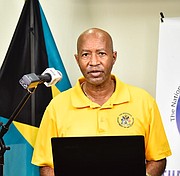By TANYA SMITH-CARTWRIGHT
tsmith-cartwright@tribunemedia.net
TREVOR Basden, director of the Department of Meteorology, is excited about the possibility of his department’s usage of the proposed Aviation, Climate and Severe Weather Network, a system that can catapult the country’s aviation and meteorological departments into cutting edge performances.
On Monday, The Tribune unveiled the network with it declaring: “$472 Million First-of-a-Kind Aviation, Climate, Marine, Ocean and Severe Weather Network, Gets Cabinet Green Light.”
Yesterday, The Tribune spoke with Met Office head, Mr Basden, who feels this network will be a move in the right direction once it is set up in his department.
“This Aviation, Climate and Severe Weather Network would allow the Department of Meteorology to move towards impact based forecasting,” he said.
“For example, if you have a tropical cyclone moving and based on how the models and the information given, can tell the various degrees and stages of damage, flood and water infiltration at various points and we could describe it more accurately.
“Right now we will just say, ‘flooding’, but we will be able to even graphically show where the water levels will be on the houses and infiltration in areas. My Doppler weather radars, mainly (allow) for me to see what is approaching The Bahamas in the distance.
“Once the system gets into The Bahamas, this new network will allow me to see street level in precipitation. Right now I cannot get street level precipitation because Doppler weather radar is not designed for that.”
Not dismissing his current equipment, Mr Basden explained that the Doppler is designed mainly to see severe tropical cyclones and severe weather, but the precipitation and the more refined detail cannot be seen by that equipment.
He said for the project to be approved, they will need a meteorological watch office. And, what that means, he said, is instead of the current aviation, public and marine forecast the Department of Meteorology will look at sectors in the atmosphere where the planes are travelling and be able to give the weather for those inflight.
Asked what the difference would be if the network was in place last year when the devastating Hurricane Dorian hit, he gave clear indication that citizens would have seen the urgency and would have been more prepared.
“In Dorian’s case, we had rapid intensification which is when a cyclone increases its wind speed by at least 35 miles an hour in a 24-hour period,” Mr Basden said.
“We would have been able when we started our watch and warning those who might have been a little hesitant in wanting to move to shelters or safety, we would have been able to show where the storm surge would be and how high it would be.
“There is nothing like a picture painting a thousand words. When you show that to people, graphically. The tone and sense of the forecast would be of greater urgency. That would have made them more aware. Obviously, from what I’ve seen with Dorian we had some unprecedented things in that no other time do I recall a Category Five hurricane remaining rather stationary and just wobbled.”
Mr Basden said there will always be meteorological challenges, but this network will allow his department to take that high level theory and make it plain for laymen to understand.
“This will allow meteorologists and forecasters to put everything in a format that the general public can see, from what we are producing, the level of inundation, the wind damage and the like,” he explained. “It would assist us in portraying more simply and understandably to the layman, the risk and the vulnerability of where they live, based on a particular weather phenomenon.”
The new network declares: “As the ICAO designated ‘Meteorological Weather Authority’ for International Air Navigation Services on behalf of a contracting state to the Chicago Convention (1944), Bahamas Aviation, Climate and Severe Weather Network shall stand up a Meteorological Watch Office (MWO) with the resources, systems and expertise to provide 24/7/365 continuous watch over Bahamas’ sovereign archipelagic baselines, territorial seas, contiguous and exclusive economic zone.”
This network involves the creation of technology for ‘severe weather sensors’ which will create highly detailed maps covering atmospheric and climate conditions, surface hydrology which are linked to air and sea traffic movements becoming vital tools during severe weather events such as Hurricane Dorian.
When put in place, The Bahamas would be able to use the network to create detailed 3D imagery showing exactly what conditions will be like - even down to individual street level - in a severe weather event.





Comments
joeblow 3 years, 4 months ago
Save the money instead os simply throwing it an another piece of technology that won't change anything. Watch The Weather Channel and invest the money in purchasing equipment and training NEMA, defense and police forces in planning and proper responses to natural disasters. Or just let Samaritans Purse run the whole thing!
Sign in to comment
Or login with:
OpenID